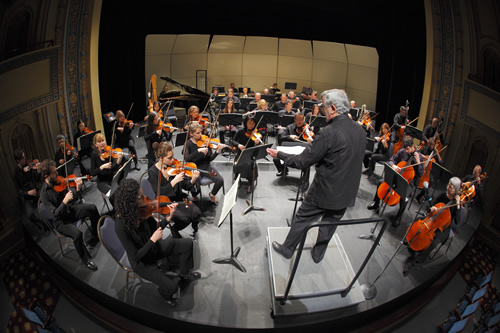Chamber Orchestra of the Triangle music director Lorenzo Muti chose as the theme “The Timeless Power of Genius” for the opening concert of the 2017/18 season. The three works spanned four centuries. A work by 21st century Mexican composer Arturo Márquez (b. 1950), was scheduled to open the program, followed by a rare performance of a 1779 serenade by Wolfgang Amadeus Mozart (1756-91), and culminating in the brilliant Symphony No.1 by the then nineteen-year old Dmitri Shostakovich (1906-75). The Carolina Theatre stage was well-filled by the augmented talented musicians and there was a good turnout of music lovers.
Muti made several announcements from the stage. For both acoustical and visual purposes, seating and musician placement were being experimented with using extra risers. The printed program was abandoned in favor of chronological order with an extra surprise for the last work. He said that the Mozart and Shostakovich works were linked in that they were composed for graduations.
Mozart’s Serenade No. 9 in D, K.320 “Post horn” was composed for the University of Salzburg’s 1779 Finalmusik ceremony. Most 18th century serenades were light background music but Mozart’s genius greatly elevated the musical level of its seven movements. Post horns were valveless, straight or coiled, cylindrical brass instruments with a cupped mouthpiece. They were used to signal the arrival or departure of a post rider or mail coach. The post horn solo occurs in the second trio of the second minuet. Muti led a superb stylish performance with many polished prominent solos from first stand players. Erin Munnelly played the unusual piccolo solo above strings in the first trio. The Concertante and Rondeau movements (Nos. 3-4) featured splendid solos from pairs of flutes, oboes, and bassoons. Pace original instrument folks, the post horn’s natural harmonics were played by David McCheney on a valved trumpet with a small bell.
Listening to the brilliant performance of Symphony No. 1 in F minor, Op. 10, I thought how happy the players of the Leningrad Philharmonic Orchestra must have been at the first performance. While Shostakovich was pursuing piano, this symphony served as his diploma exercise for his composition course at Leningrad Conservatoire. Every section of the orchestra has at least a prominent solo and sometimes divided stand solos. Muti led a taut performance bringing out all of the sassy and sarcastic elements in the composer’s imaginative score so packed with elements of his mature style. The third movement Lento was filled with antecedents of the emotional depths of the mature composer and his coded responses to Stalinist suppression.
Prominent solos were had from concertmaster Tasi Matthews and stand mate Grijda Spiri, cellist Rosalind Leavell, flutist Jill Muti, piccolo player Cathy Stewart, oboist Bo Newsome, clarinetist Kevin Streich, bassoonist Chris Ulffers, and principal horn Andrew Merideth. The post horn part was delivered by principal trumpet Chesney. Olga Kleiankina gave a scintillating performance of the extensive solo piano part. The vivid timpani part was skillfully played by Scott Pollard. The musicians delivered a searing intensity to this seminal work.
Arturo Márquez, born in Álamos, Sonora, drew upon the music of the Veracruz region of Mexico for the music of his Danzones. Danzón No. 2 gave the composer international exposure when the 1994 piece was included on the program of the Simon Bolivar Youth Orchestra conducted by Gustavo Dudamel on their 2007 Tour of the USA and Europe. Multiple accents and tempi add considerable rhythmic interest. This was the first of a season-long series of 20th and 21st century music made possible by a grant from the Durham Arts Council and funds from The Robert Ward Endowment.
The surprise coup was that Danzón No. 2 was superbly led by Niccoló Muti, music director Muti’s son, stepping up from his stand in the first violin section. His beat was clear, economical, and effective as he steered the musicians through Márquez’s frequent and abrupt changes of accents and tempi. Splendid solos were had from clarinetist Streich, oboist Newsome, pianist Kleiankina, first trumpet McChesney, and Munnelly on piccolo. The extensive percussion section delivered the goods in spades. The orchestra reseating certainly made it easier to see all the players.











